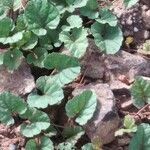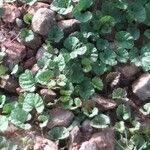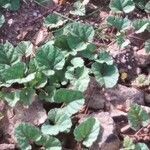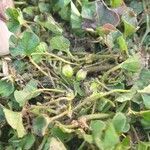Herbs perennial, prostrate; axial parts sparsely hirtellous or glabrescent. Stems rooting at nodes, becoming tuberculate. Petiole 0.2-3.7 cm; leaf blade reniform to broadly ovate, 0.5-3.5 X 0.6-3.5 mm, glabrous or sparsely appressed pilose, base cordate, margin entire or coarsely crenate, apex obtuse to broadly rounded or slightly emarginate. Inflorescences subsessile, 1(-3)-flowered; bracts unequal, ovate to linear, pubescent, apex acute. Pedicel 2-4 mm. Sepals obovate to circular or subquadrate, ± pubescent abaxially, margin long ciliate; outer 2 sepals 2.5-3 mm, apex obtuse, hoodlike and distinctly mucronate; inner 3 sepals 3-6 mm, deeply emarginate. Corolla yellow, tubular-campanulate, 5-9 mm, midpetaline bands distinctly 5-veined, purplish tinged outside, inside pubescent basally; limb slightly 5-lobed. Filaments pubescent basally. Ovary glabrous. Capsule enclosed by persistent calyx, brown-black, ± globular, 5-6 mm, longitudinally grooved, glabrous, apiculate. Seeds grayish brown, ca. 2.5 mm, glabrous. 2n = 30.
Perennial; stems prostrate from a woody root, up to 75 cm. long, rooting at the nodes, sparsely hairy or glabrescent.. Leaf-blade orbicular or ovate-reniform, 0.5–3.5 cm. long and wide, rounded or emarginate at the apex, cordate at the base with broadly rounded sinus and basal lobes, entire or coarsely crenate, glabrous or sparsely pilose; petiole up to 3.8 cm. long.. Flowers axillary, solitary or in 2–3-flowered cymes; peduncle very short or absent; pedicels 2–4 mm. long.. Sepals 2.5–6 mm. long, 1.3–3 mm. wide; outer shorter, obovate-elliptic, obtuse or subacute at the apex, glabrous; three inner longer, obovate, obcordate or orbicular, obsoletely cuspidate, the upper margins ciliate.. Corolla yellow with pale or dark base and with midpetaline areas sometimes purplish or red-flushed, tubular-campanulate, 5–9 mm. long, glabrous.. Capsule globose, 4.5–6 mm. in diameter.. Seeds glabrous, about 3–6 mm. long, dark brown.
A herb. It lies along the ground and keeps growing from year to year. The stems form roots at the nodes. The leaves are kidney shaped or oval and 1-4 cm long by 1-4 cm wide.




